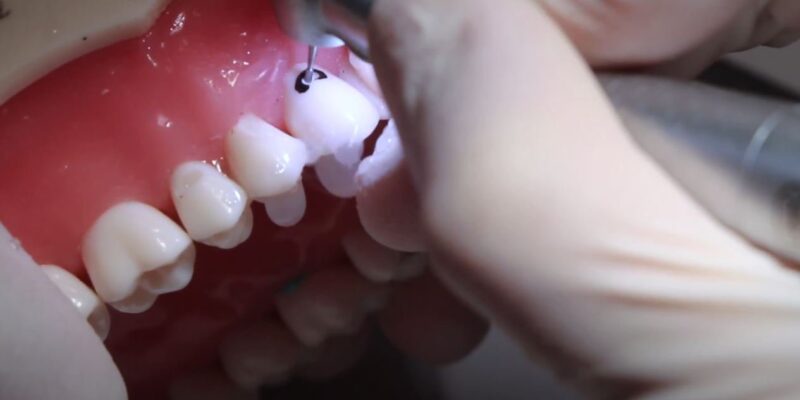Dr Alpa Savla is the winner at 2nd position, the critics award of excellence for DR Pronto Esthetic Challenge 1, 2021-2022
Introduction
Development of different restorative materials presents the modern dentist with several choices when deciding how to best restore cervical cavities on the teeth.
Commonly known as Class V cavities (GV Black), materials considered appropriate for Class V restorations are:
- amalgam
- composite resin
- glass ionomer
- resin modified glass ionomer
- compomers
Many Class V restorations are non carious lesions and present with little or no retention form. In such situations, the potential for material to bond to the tooth is most important as it may avoid the need to prepare sound tissue to achieve retention.
When cervical outline of the cavity is placed in dentin, it is difficult to obtain a proper and lasting marginal seal of the restoration (Phair and Fuller, 1985; Pintado and Douglas, 1988; Tortenson and Brannstorm, 1985). The main cause is polymerization shrinkage, which is directed incisally toward the reliable and strongly bonded enamel-composite interface (Davidson et al., 1984; Crim, 1987, Davidson and Kemp-Scholte, 1989).
A possible solution to this problem may be the application of material that renders the restoration sufficiently flexible to compensate for that part of shrinkage that challenges the bond.
Challenges in restoring Class V defects
- Class V cavities are multi-factorial in origin
- Polymerization shrinkage/C-factor stress resulting in failure
- Sealed gaps under the restoration
- Stress due to biting pressure causing the restoration to fail
- Cervical outline of the cavity in the dentin resulting in incomplete marginal seal.
Case Report
A 65 year old male patient presented with deep Class V lesions in tooth no 34 & 35.
Cavity preparation
- 0 no. retraction cord was placed to expose the cervical margin of the cavity.
- Cavity was prepared by bevelling the margins and air abrasion.
- Selective etching of enamel was carried out, followed by bonding (3M Adper Single Bond 2) was used.
Incremental layering
- The first increment of the composite (Activa™ Pronto, Pulpdent® USA) was placed (less than 2 mm) from coronal to cervical and polymerised.
- Second increment was placed cervical to the first increment and adapted slightly closer to the cervical margin.
- The final increment was placed in the cervical region.
Finishing and polishing
- Contouring was achieved using burs (SS White finishing burs).
- Restoration was polished (Shofu Super Snap discs).

Discussion
Layering/incremental built up with bioactive filling materials such as Activa™ Pronto (rubberised resin) in Class V cavities very close to the pulp allows for fewer stresses to develop within the restoration, lesser shrinkage and long term marginal seal.
Restoring the dentin with thin horizontal layers that are 2 mm or less ensures that decoupling with time is properly achieved thereby reducing C factor stresses.
Using a hydrophillic resin like Activa™ Pronto in subgingival restorations facillitates ionic interaction that binds resin to the minerals in the tooth, forming a strong resin-hydroxyappatite complex and a positive seal against microleakage.
Summary
There is much debate and interest among clinicians as to which is the ‘best’ restorative material for different situations. Occlusal factors are considered to be important in the etiology of Class V cavities.
The use of rubberised resin (Activa™ Pronto, Pulpdent® USA) which can absorb stress and resist fracture can help the clinician in making highly durable and very esthetic Class V restorations.
Frequently Asked Questions:
-
What is a Class V restoration?
A Class V restoration refers to a dental procedure where a dentist repairs a cavity or defect located on the smooth surface of a tooth, typically near the gumline or the root surface. This type of restoration is commonly used to address decay, erosion, abrasion, or fractures in these specific areas of the tooth.
-
What causes the need for a Class V restoration?
Class V restorations are often required due to factors such as improper brushing techniques, acidic foods and beverages, gum recession, and toothbrush abrasion. These factors can lead to the gradual wearing away of enamel in the vulnerable areas near the gumline or root surface, making the tooth susceptible to decay and other damage.
-
What materials are used for Class V restorations?
Dentists typically use tooth-colored materials for Class V restorations, such as composite resin or glass ionomer cement. These materials are aesthetically pleasing and can be matched to the natural color of the tooth. They also provide a strong bond with the tooth structure, helping to restore its functionality and appearance.
-
What is the procedure for a Class V restoration?
The procedure involves several steps:
- Anesthesia: Local anesthesia is administered to numb the area, ensuring a painless procedure.
- Preparation: The dentist removes the decayed or damaged portion of the tooth, creating a clean surface for the restoration.
- Etching and Bonding: The tooth surface is etched to create a rough texture, and then a bonding agent is applied to promote adhesion between the tooth and the restoration material.
- Placement: The chosen restoration material (composite resin or glass ionomer) is placed onto the prepared tooth and shaped to match the natural contours.
- Curing: A special light is used to harden and set the restoration material in place.
- Finishing: The dentist trims and polishes the restoration to ensure a comfortable bite and a smooth surface.
-
How long does a Class V restoration last?
The lifespan of a Class V restoration depends on various factors, including the quality of the materials used, the patient’s oral hygiene habits, and the location of the restoration. On average, well-maintained Class V restorations can last anywhere from 5 to 15 years or more. Regular dental check-ups and proper oral care can extend the longevity of the restoration.




















Comments